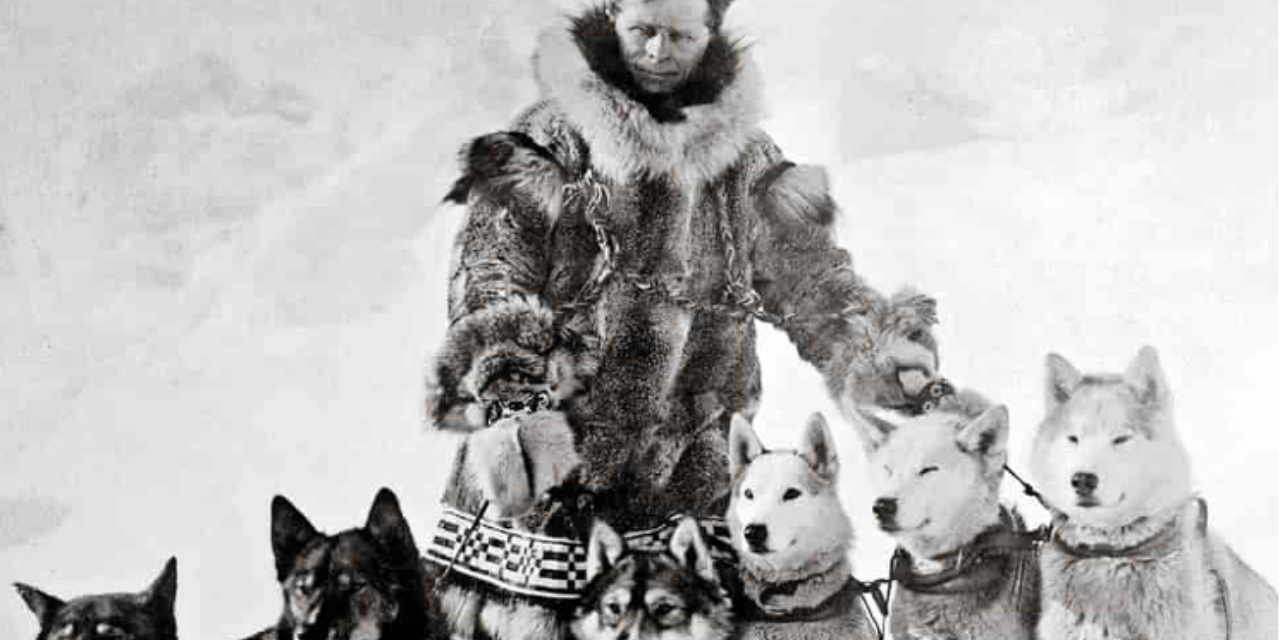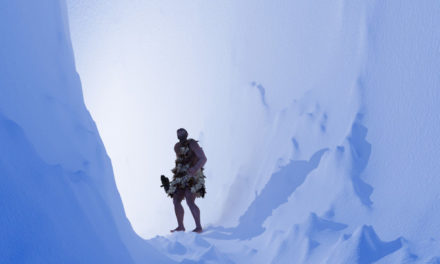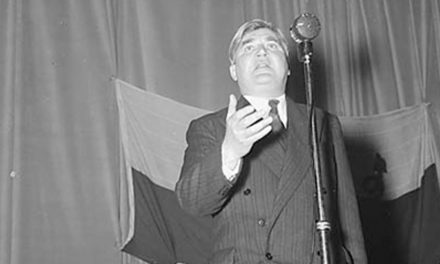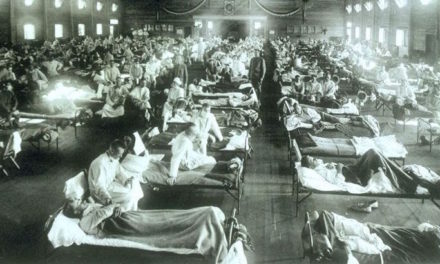Thanks to modern childhood vaccination programs, diphtheria is now a rare illness in Western Europe and the United States. It is still common, however, in developing countries where vaccination rates are low. It is a terrifying illness caused by the airborne bacterium Corynebacterium diphtheriae, which releases a potent toxin.
The symptoms start with a raging fever, and those affected, often children, develop a hoarse voice, sore throat, cough, breathing problems, neck swelling (the bull neck) and difficulty swallowing. Some are affected mildly, but even with the availability of modern medical facilities, up to 10% of those who contract the illness die.
A child with diphtheria demonstrating the characteristic ‘bull neck’ (Image courtesy of the Centers for Disease Control and Prevention Public Health Image Library)
An outbreak in Nome, Alaska
In December 1924, Dr Curtis Welch, the lone doctor in a small, isolated town on the west coast of Alaska on the shore of the Bering Sea, was called to see several small children with sore throats. He diagnosed them with tonsillitis, but in the back of his mind was the possibility of diphtheria. A few months earlier, he had discovered that the town’s entire supply of diphtheria antitoxin was expired. He had ordered a fresh supply, but the shipment did not arrive before the port closed for the winter. The cases continued to occur and grew in number, and over the next few weeks, four children died in the surrounding area.
A couple of weeks later, in January 1925, Welch was called to see a three-year-old boy who had become unwell with a sore throat and a fever. He immediately recognised the classic symptoms and signs and diagnosed diphtheria. The child died two weeks after developing the symptoms. The very next day, he was called to see a second child, a seven-year-old girl with the same illness. He gave her some of the expired antitoxin that he had in the hopes that it might still work, but she died a few hours later. The stark realisation that an epidemic was imminent hit home, and he called an emergency town council meeting.
The town council decided to implement a quarantine with immediate effect, and telegrams were sent to all the surrounding towns. There were particular concerns for the native Alaskans living in the surrounding area, who were subject to much higher mortality rates because they had no resistance to the disease. The US Public Health Service was also contacted urgently for help. Despite the quarantine, cases continued to rise, and there were 20 more confirmed cases and another 50 deemed high risk by the end of the month. An unmitigated disaster was imminent.
A desperate and dangerous solution
Diphtheria antitoxin was desperately needed, but the harsh Alaskan winter made this difficult. Ships could not reach Nome in winter, and the nearest town with a railroad was Nenana, almost 700 miles away. After a series of discussions, it was decided that the best way to organise the collection of the antitoxin from Nenana was via dog sled teams.
On January 26th, 300,00 units of antitoxin were fortuitously discovered in a hospital in Anchorage. These were packaged and immediately sent to Nenana, where they arrived the next day. These 300,000 units would not be enough to eradicate the outbreak completely, but they would be able to sufficiently slow the spread of diphtheria until a larger shipment could arrive, saving many lives.
Two dog sled teams were assembled; one would leave from Nome and the other from Nenana carrying the antitoxin. It was arranged that the two teams would meet halfway in the town of Nulato, which was situated approximately halfway between them. The conditions were brutal, with temperatures averaging at -30 degrees, at places falling to -50 degrees, and windspeeds reaching 25 mph causing huge 10 feet tall snowdrifts. It was estimated by Welch that the antitoxin would last only six days in the extreme Alaskan weather conditions. The race to Nulato was on.
Leonard Seppala and Togo lead the way
Twenty dogsled teams were assembled to undertake the relay, one of which was led by Leonard Seppala. The Norwegian-born Seppala had already become a local dogsledding legend known for his rapport with his Siberian huskies and remarkable athleticism and resilience. Seppala’s lead dog was the 12-year-old Togo, a natural leader, who had demonstrated extreme dedication, incredible endurance, and unusual intelligence during his time with Seppala. Seppala and Togo’s team would be pivotal to the relay’s success.
Leonard Seppala and his dogsled team, Togo far left. Wikipedia
Courtesy of the Carrie McLain Museum CC BY-SA 1.0
The relay started with musher ‘Wild Bill’ Shannon collecting the antitoxin at the train station in Nenana at 9 pm on January 27th. Shannon ran into dreadful conditions in this first stretch of the westward journey and developed hypothermia. Three dogs in his team also died. He arrived in the small village of Minto at 3 am with his face blackened from frostbite. Here he handed over the antitoxin to the next musher.
At the other end in Nome, Seppala, Togo, and their team set off east on the same day. They made incredible time while travelling into a fierce oncoming storm, covering over 170 miles in only three days. To shorten the journey and save time, Seppala decided to cross the treacherous Norton Sound. Racing to get off the Sound before a storm hit, Seppala nearly missed Henry Ivanoff, the musher in the relay team carrying the serum westward at this point. Fortunately, Ivanoff shouted, “The serum! The serum! I have it here!” at the last minute, allowing them to meet and pass the antitoxin on to Seppala.
Seppala then turned around and started the journey back to Nome. The return trip would prove to be even more perilous, and at one point, the team became stranded on an ice floe. In an attempt to rescue them and salvage the relay, Seppala tied a lead to Togo and threw him five feet across the water. The line snapped, but somehow the incredible Togo snatched the line from the water and pulled the team to safety.
Kaasen and Balto to the finish line
Eventually, Seppala’s team made it to the Golovin, situated 78 miles from Nome, where the antitoxin was handed on. Several teams then completed the relay, with the musher Gunner Kaasen completing the last stretch in charge of another of Seppala’s dog teams, this one led by Balto. They arrived back in Nome to a hero’s welcome, ahead of schedule, at 3 am on February 2nd.
Gunnar Kaasen and Balto (Image courtesy of the National Institutes of Health)
Not a single ampoule was broken during the journey, and the antitoxin was thawed out and ready to use by noon. The number of cases in Nome had risen to 28, and there was enough antitoxin available to treat 30 people.
Kaasen and Balto became celebrities after completing the final stretch and delivering the antitoxin. A few months later, a statue of Balto was erected in New York City’s Central Park. Togo received no credit, and his heroics were largely forgotten. But there was only one true hero in Seppala’s eyes, who later stated:
“I hope I shall never be the man to take away credit from any dog or driver who participated in that run. We all did our best. But when the country was roused to enthusiasm over the serum run driver, I resented the statue to Balto, for if any dog deserved special mention, it was Togo. At the time I left [for the run], I never dreamed that anyone could consider these dogs [the second string] fit to drive even in a short relay. As to the leader, it was up to the driver who happened to be selected to choose any dog he liked, and he chose Balto.“
All of the dogsled teams combined covered 674 miles in 127½ hours. Togo and Seppala and the 12-year-old Togo travelled an astonishing 264 miles, compared to an average of 31 miles each for the other teams. In recent years, however, Togo has finally received the recognition he deserved for his heroic efforts in 1925. In 2011, Time Magazine named Togo the most heroic animal of all time:
“The dog that often gets credit for eventually saving the town is Balto, but he just happened to run the last, 55-mile leg in the race. The sled dog who did the lion’s share of the work was Togo. His journey, fraught with white-out storms, was the longest by 200 miles and included a traverse across perilous Norton Sound – where he saved his team and driver in a courageous swim through ice floes.”
And more recently, in 2019, the story was made into an excellent film starring Willem Defoe as Seppala.







Recent Comments